495 French Sporting Breeds
THE FRENCH CONNECTION
by David Hancock
 Of the foreign breeds recognised by the Kennel Club, those from Germany dwarf any other national contribution, and, bearing in mind the proximity of France, it is surprising that some admirable French breeds have gone unfavoured here. Of the dozen-plus French breeds recognised and patronised by us, the vast majority are relatively recent recognitions. The braque and epagneul breeds are still not favoured by British sportsmen, despite their field prowess and the growing and justified popularity of the Brittany. Of the many French breeds of gundog, the latter is the only one recognised here as such, of the dozen or so in existence.
Of the foreign breeds recognised by the Kennel Club, those from Germany dwarf any other national contribution, and, bearing in mind the proximity of France, it is surprising that some admirable French breeds have gone unfavoured here. Of the dozen-plus French breeds recognised and patronised by us, the vast majority are relatively recent recognitions. The braque and epagneul breeds are still not favoured by British sportsmen, despite their field prowess and the growing and justified popularity of the Brittany. Of the many French breeds of gundog, the latter is the only one recognised here as such, of the dozen or so in existence.
The French Poodle, once a water-retriever languishes in our Utility Group, whilst of its sister breeds, the Italian Lagotto Romagnolo is destined to be, and the Spanish Water Dog is, listed in the Gundog Group, the Portuguese Water Dog is in the Kennel Club's Working Group and our Irish Water Spaniel is acknowledged as a gundog. The likely founder of them all, the Barbet, is unknown here, although its diminutive form, the Barbichon or Bichon family of Toy dogs, is favoured. The Bichon Frise, the Havanese, the Bolognese and the Coton de Tulear, from a wide field, all have followers here. The Barbet is likely to have spawned the Lowchen, in some ways a miniature water-dog, a type of dog which attracted the 'lion clip' in its coat. 
The first time I saw a Brittany I thought it was a Welsh Springer Spaniel, so vivid-red was its coat. And the connections between Brittany and Wales are many; the rough-coated Welsh Foxhound has a distinct 'griffon' look to it. The chestnut Basset of Brittany, or Fauve de Bretagne, now established here, has that griffon look, with a harsh dense flat coat. Betty Judge has now brought in the Grand Griffon Vendeen and the smaller Briquet Griffon Vendeen, to reinforce the Vendeen Bassets already here. Our favouring of smooth-coated scent hounds has left us just with the Otterhound of our packhounds with a griffon flavour, although I suspect that the French would have named our Airedale a griffon.
The first time too that I saw an Epagneul Francais, I thought it was an Irish Red and White Setter. It is easy to mistake a Braque St Germain for our Pointer or to identify the bigger Braque Francais as a GSP. The Epagneul Picard can be confused with a heavily flecked blue belton English Setter. The Epagneul de Pont-Audemer has a whiptail look to it and the Griffon a poil dur or Kortals Griffon is much like the Cesky Fousek and the Drahthaar or GWHP. French scenthounds like the quaintly named Billy, the Francais Tricolore and the Poitevin resemble our Foxhound, which has often supplied new blood to the French packs. There has long been exchanges of sporting dogs between Britain and France.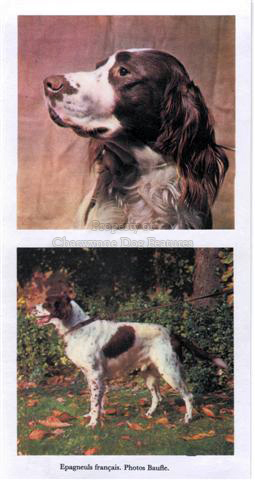
Ear length sometimes distinguishes French scenthounds from ours, as the Porcelaine demonstrates. But their native bassets, such as the Artesien-Normand have much shorter ears than our show type of Basset Hound. But there are nearly thirty breeds of French scenthound and nearly all of them are little known here. The Vendeen Griffons and the Grand Bleu de Gascogne are now making progress here but most of the others are restricted to France and the Franco-Swiss border country, like the Bruno de Jura, a handsome black and tan breed. Perhaps in the fall-out from the Hunting with Dogs Act, British sportsmen, pursuing their sport in France, will become better acquainted with them. There are over 300 packs of hounds in France: 35 staghound, 73 foxhound, 61 roebuck, 114 harehound and 14 packs of boarhound.
Hunting in France continues the ancient and aristocratic attitude to 'venery', the exercise of the art and science of hunting. It is divided into two types, depending on the quarry: la grande and la petite venerie. The former, with quarry of stag, roebuck and boar, is steeped in tradition, with a pageantry and formality passed down from a bygone aristocratic era; it is supported by over 100 packs. The wolf was hunted until its extinction in the 1930s. Most packs of la petite venerie hunt the hare, but 20% hunt the fox. The French breeds of hound have great voices, pace and nose but have been accused of lacking drive and stamina. This has led to infusions of Foxhound blood from here. Some packs are Anglo-Francais, but most have retained the old breeds, preserving the great ringing cry of the classic French scenthound. It is worth noting that hunting is enshrined in the laws of the French constitution; we hunt within the law, they hunt by it.
But just as the blood of our Foxhound has been used to the benefit of French hounds, so too has the blood of theirs been used here. It has been argued that, without the Norman Conquest, we would be without our scenthounds. It has been argued too that all the scenthounds in the world come from either British or French stock, or a blend of the two, as in the United States. Hound expert Sir John Buchanan-Jardine has argued that the Norman Hound, now extinct as such, acquired the name here of Talbot Hound, citing the words of Gervase Markham, Blaine and TB Johnson (Hunting Directory, 1826) as evidence. Markham wrote that 'The shag-haired Talbot, preferably grizzled, were ...chosen to hunt the fox, badger and other hot scents.' The Bresse breed from Eastern France was brought here to form the basis of Welsh hounds; they were shaggy and grizzled.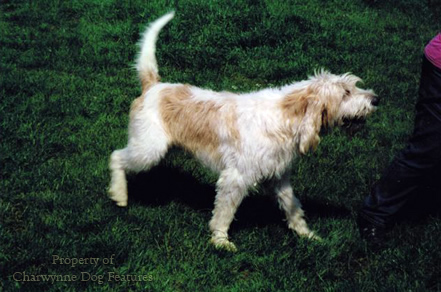
The St Hubert hounds have also been dubbed Talbots, a name which some believe is an English misuse of Taillebois, the Abbot of St Hubert's Monastery in the seventh century. Because of their scenting prowess, the St Huberts were distributed to the French aristocracy in all parts of France, were bred with local stock but played a major role in the development of scenthounds on both sides of the channel. In early days each local breed of French hound was found in three versions: chiens d'ordre or full-sized, chiens briquets or medium-sized and chiens bassets. The latter were sub-divided into three sub-types, according to the structure of the foreleg: straight-legged, half-crooked and full crooked. Nowadays we tend to think wrongly of all true Bassets being only the full crooked foreleg version. The contemporary straight-legged English Basset, achieved with the help of Harrier blood, is therefore a quite legitimate Basset, not a modern innovation.
Strangely, the French, with their great passion for hunting, have never developed their own sighthound, although to be fair neither has any mainland northern European country. But they have produced their own 'beardie' and in more than one form. Care is needed however in using the expression beardie for French sheepdogs; barbet, the name given to their original water-dog, translates as bearded dog. But they do have several beardie types, ranging from the Briard, equating to our Bobtail, to the Picardy sheepdog and the Pyrenean sheepdog, now appearing here. Their shepherd dog is the Beauceron, a handsome impressive breed, strangely not promoted here and placed by the Kennel Club, when recognising the breed, in the Working not the Pastoral Group, where the shepherd dogs of Holland, Belgium, Germany, Australia and Anatolia feature. Other French pastoral dogs, such as the Berger de Bresse, the Berger de Savoie, the Farou of Languedoc and the Labrit from Les Landes in the south-west, are probably now lost to us as breeds.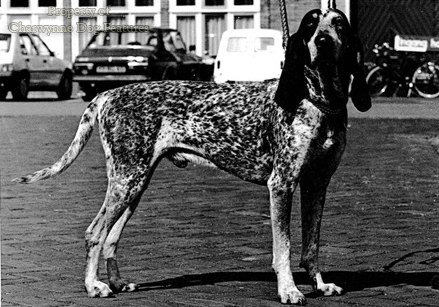
Lost too are the scenthound breeds of Levesque, Bresse, Auvergne and Gris de St Louis, (mostly subsumed into other packs), together with the gundog breeds of Dupuy, and Charles X pointer, with the Braques from Ariege, Auvergne, Gascogne and Bourbon surviving but not flourishing. The Bourbonnais Pointer is shown at FCI shows, with over 100 registered annually, after nearly disappearing in the 1960s-70s. Some are born tail-less or with just a rudimentary tail. A distinctive breed, with a very individual coat colour, roan with a pattern described either 'dressed like a trout' or 'lie de vin' (dregs of wine). I have heard this breed described as a short-haired Brittany in North America but my French colleagues dispute this. It is good to know that such a distinctive sporting breed has been saved.
Now thriving after fading from view at times in the past is the French mastiff, the Dogue de Bordeaux. Likely to have been developed from English stock, Bordeaux having been English-run for three hundred years, the breed is well established here, with nearly 2,000 registered in 2005. I do hope that quantity isn't going to preclude quality; I am unimpressed by a large number of this breed that I see at shows. The mastiff breeds, being short-haired and substantial, look quite awful when unfit, over-weight or in poor condition. Their movement suffers and their cumbersome gait does the breed a disservice. The KC standard expects movement that is free, supple, with good drive from behind. I often see laboured movement, with limited reach at the front and poor extension at the back. Raymond Triquet, the great expert on this breed, places great importance on what he calls 'the mobility of the shoulder', blaming a lot of poor movement on rings that are too small for such a powerful breed.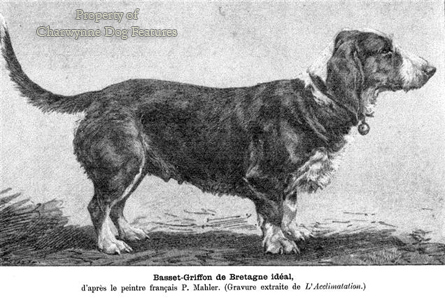
The smaller French 'dogue', the French Bulldog, is also expected to display free and flowing movement and is the epitome of a small sturdy, solid, compact dog. I don't like the wording in their breed standard which asks for an extremely short nose. I am glad that under general appearance a caveat has been added to the effect that a dog showing respiratory distress is a highly undesirable feature. Prominent eyes are not desired either. Dogs with bulging eyes and truncated muzzles are done no favours by their breeders. Light eyes and too much leg length doesn't suit this admirable little breed but the restricted extension in the hindquarters is more worrying. I see far too many with stiff stilted hind movement and a distinct lack of forward extension in the hindlegs. This can give a waddling gait to the breed which is most unattractive. Small dogs need sound movement just as much as their larger relatives.
A much larger relative is the Pyrenean Mountain Dog, once justly named the Royal Dog of France. There is a measurable regality about the breed. Bernard Senac-Lagrange, the saviour of the breed in the early 20th century, once said of them: "Only the true breed possesses this bewitching, almost indefinable expression in the eyes, both distant and caressing, contemplative and just a little sad. As you look in these eyes the immense moral value of the breed pierces your soul." An undeniably glamorous breed, it is vital for their function as flock guardians to be respected. I see far too many which have flat feet, are under-muscled through lack of exercise and flop along, without drive, on the move. A transhumance breed needs superb feet, great physical condition and strong but effortless movement. The head should distinguish the Pyr from the other big white pastoral breeds; a short square skull gives the breed an untypical look which degrades essential breed type. But France has every reason to be proud of this imposing breed.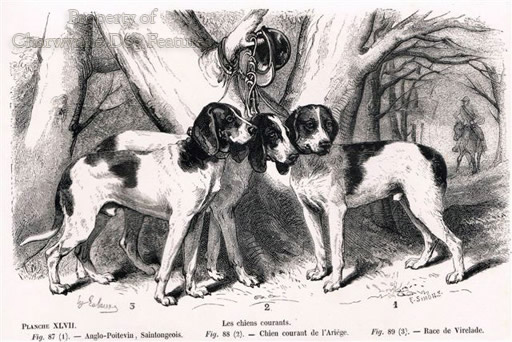
I have yet to meet a Frenchman who is proud of the Poodle, but I admire them. They are clever dogs and the standard variety is underused as a gundog. Clipped to look like a Curly-coated Retriever, they look workmanlike and utilitarian, rather than exhibition items. Years ago, a Dorset sportsman used them extensively as retrievers and never found them wanting. ver dogs and the standard variety is underused as a gundog. Clipped to look like a Curly-coated Retriever, they look workmanlike and utilitarian, rather than exhibition items. Years ago, a Dorset sportsman used them extensively as retrievers and never found them wanting. A French sportsman, so anxious to distance his country from the Poodle, assured me that they were Russian in origin and German in development. He cited the Pudelpointer and the Schafpudel as German variations on the type. The word Pudel is German and the French do call the breed the Caniche, derived from Chien Canard or duck-dog. My French colleague insisted that the French water-dog was the Barbet and the German the Pudelhund. The corded Poodle or schnur Pudel has been dubbed the Russian Poodle. The 19th century German cynologist Dr Fitzinger listed six different varieties of the breed, but maintained that the standard version originated in north-west Africa.
Does it truly matter where breeds originated? Probably not, but their original function really does matter. The Briard, the Brittany, the Barbet, the Braque Bourbonnais and the Beauceron each underwent a separate development in keeping with their use. That is how their physique was shaped, their anatomy tried and tested and their character induced. Keeping faith with the pioneer-breeders is a key element in breed loyalty. In any country, in any breed, that is the only honest way to proceed.